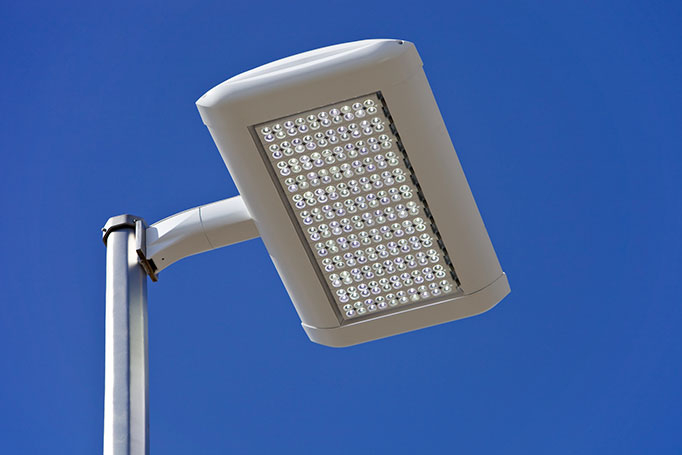Kroger recently notified all its landlords that if they would upgrade their parking-lot lighting to light-emitting diode systems this year, the supermarket chain would pay a portion of the cost. Perhaps that says a lot about the importance of lighting in today’s retail world. The biggest leap in lighting has been the move from fluorescent lighting to high-efficiency LED systems that last a lot longer and provide better light, according to industry consultants.
“Lighting technology in the last 10 years has really exploded by leaps and bounds,” said Michael Alexander, vice president of sustainability at Cushman & Wakefield. “For shopping center owners, the question is: ‘Has the technology exploded enough that it is going to potentially require them to retrofit again, even if they retrofitted three or five years ago? Is it worth the expense?’ The answer is yes.”
The return on investment for a complete interior lighting overhaul of the typical mall can average from one to three years, says Barry Wood, a JLL senior vice president who is director of operations. “The lower costs help keep their CAM rates down, and if you are on a fixed CAM, then that is income,” said Wood. “If you are on a triple net, that helps lower your CAM rate so you can get a better rent rate.”
Commercial application of LED technology emerged about five years ago, and the pricing has dropped every year since to make it more affordable for center owners. “The first two or three years, LED lightbulbs were significantly expensive, even though their savings actually justified their high cost,” said Alexander. “But as the cost of LED light bulbs is driven down, it has only accelerated the argument to retrofit.”
“For shopping center owners, the question is: ‘Has the technology exploded enough that it is going to potentially require them to retrofit again, even if they retrofitted three or five years ago? Is it worth the expense?’ The answer is yes”
But landlords should exercise caution, experts say. Alexander advises working with qualified contractors who will be around as long as the standard 10-year warranty on the LED systems they sell. “There have been a lot of LED contractors that have sprung up recently who offer discounted bulbs, but you want to make sure that you are working with a provider that has staying power, has a great reputation and is willing to work with you through the term to ensure that your solution is working,” said Alexander.
Wood concurs. “We have had a few lighting projects where someone has come in with a terrible product, and three years later we are having product failures,” Wood said. “The biggest thing is knowing your product on the front end, knowing what your return on investment is, and a big thing is coloration — understanding what colors are going to look best in your facility.”
Lighting quality is a major consideration for interior lighting. “You go with too much of a bright white light, and it is going to make your property very stark or very sterile,” Alexander said. “And that is why I really like to utilize consultants to help take what we have inside the center — our floor tile and our wall colors and things like that — to make sure that we have the right temperature of light in our fixtures.”
Another focus is on the quality of lighting for security cameras that need to render detailed images in cases of theft and other crimes. “That is something that needs to be taken into account when you are evaluating the project: How does a particular lamp look from a security standpoint?” noted Alexander.
“A big thing is coloration — understanding what colors are going to look best in your facility”
Lighting requirements for parking lots and garage structures have become a primary concern lately, given the heightening of public safety awareness, but they also offer tremendous energy savings. “The return on investment with parking structures is much faster, because you are lighting that structure day and night,” said Wood.
Often shopping center owners find it easier to retrofit a parking structure before tackling an interior lighting project, notes Alexander. “If you find success outside, then, naturally, you should be able to find success inside, because they are really kind of testing it in an area that might not have as much of an impact directly on the experience,” Alexander said. “From there, they are starting to look at where they can retrofit inside the building, typically starting with common areas, entrances and corridors.”
Many local ordinances governing lighting levels have changed substantially over the past 20 years, and owners often have to upgrade their lighting to remain in code. Many jurisdictions mandate high-lumen lighting in parking garages, for instance, so that people’s eyes do not have to adjust from the sunlight outside, says Wood.

Fort Worth, Texas–based WLS Lighting Systems has installed lighting in some 6,000 shopping center parking lots and structures over the past 20 years, according to CEO Dean Pritchard. “The parking lot is the first place you enter and the last place you leave, so it is quite important, and lighting is so key,” Pritchard said.
Two recent WLS projects involved retrofitting the parking structures at Westfield Fashion Square, in Sherman Oaks, Calif., and at Glendale (Calif.) Galleria. The firm replaced existing lighting in two parking structures at Westfield Fashion Square with over 600 LED fixtures controlled by sensors that keep lights off until movement is detected. Overall, the LED retrofit reduced the energy usage in the parking structures by nearly 76 percent, for an annual savings of nearly $63,000. At the GGP-owned Glendale Galleria, WLS completed a similar retrofit that saved the owner an estimated $133,542 in energy costs.
“It is proven that bright shopping centers with bright parking lots generate more nighttime traffic,” said Pritchard. “Eventually, everything is going to be LED — interior and exterior.”
By Ben Johnson
Contributor, Commerce + Communities Today

